After more than two decades of discussion, the North Carolina Department of Transportation is getting the ball rolling on the long-debated Interstate 26 Connector project, intended to improve traffic flow and bring the Asheville highway system up to current Interstate standards.
At an open house and public hearing on Monday, Nov. 16, N.C. DOT staff and hundreds of residents flooded the Renaissance Hotel’s Grand Ballroom, studying the traffic patterns across giant maps plastered up around the room.
The Connector project is broken up into three segments: Sections A, B and C.
At the northernmost end, Section B covers the downtown/West Asheville area — from the Haywood Road exit to the Patton Avenue throughway, up to the actual connection and/or separation of I-26 and I-240. For Section B, the DOT is considering four different design alternatives, all of which show different ideas on bridging the French Broad River.
Section C covers the I-26 and I-40 junction in Southwest Asheville, near the Enka-Candler area. There are also four alternatives for the construction of this area’s improvements — mostly a debate over which style of interchange ramps to use.
Spanning the middle of these two projects, Section A was one of the most debated segments of the night. The DOT offered no alternative options to choose from, and the project proposes an 8-lane highway running through West Asheville.
Currently, Section A’s roadway is a 4-lane highway, so the proposed plan is to double the Interstate’s width through this area. But, right before the public hearing, N.C. DOT department head Drew Joyner explained that this part of the project would be the very last component constructed.
Each alternative has its pros and cons, explained Construction Engineer Rick Tipton. And currently, “there’s not a preferred alternative,” he said. “Even if I told you my personal preference, it wouldn’t really mean anything. The point of being here tonight is to gather public input to help us make the best decision.”
But, as some residents voiced during public comment, some of those “cons” mean displacing residents and business owners in a town that’s already strapped for buildable land.
“We need a road to Asheville — not through Asheville,” said Alan McGuinn, architect at ARCA Design and board member at Asheville Design Center.
Because the Design Center helped create the 4B alternative in Section B, that’s the plan that the group favors, McGuinn said.
The idea with 4B is to create overall roadway improvements, he explained, while still remaining “sensitive to urban design,” McGuinn said. “It’s more compact; it’s a tighter design. … You don’t design an urban road like you’re out in open, rural country.”
And that’s what the 3 and 3C alternatives suggest, he implied.
Those two options seem to be the most obvious connections: a straight path over the French Broad, connecting the I-26 thru-traffic and allowing drivers to avoid the current 4-lane hop and sharp turn back north.
And with fewer complications comes fewer expenses. “It’s the least expensive option,” McGuinn said. “But it’s not about what’s cheapest. It’s about the best value. Sure, [3C] is cheaper: It’s not doing as much.
“But even 4B needs some additional work,” he added. “[The idea] is not totally complete.”
And the DOT staff said they’ll keep working on the design even after choosing an alternative — but they’re looking to public comment for advice to first make that decision. (See sidebar for ways to submit your opinions).
According to the timeline, the DOT will select the preferred alternative by spring 2016 and, soon after, will begin finalizing a plan before the next public hearing in 2017. Acquisition of the homes and businesses in the right of way (shown in green on the maps) will take place in 2019 for Section C and in 2021 for Section B. And construction on B and C is expected to begin in 2021 and 2024, respectively. Section A progress will begin an undetermined amount of time after that.
During the public hearing, many prominent figures from around Western North Carolina stood up to give their two cents on the project.
Madison County Commissioner Matthew Wechtel was the first of the bunch to speak, saying that the I-26 Connector project isn’t just a Buncombe County issue — it’s a regional issue. Many Madison residents “have to go through what I refer to as ‘malfunction junction,’” he said. There needs to be a way to ensure residents can “travel through the counties safely” — because it’s not just about the economic development that comes with thru-traffic, he said. It’s about “the safety of those who have to travel through [this] area.”
In a speech that drew uproarious applause from the crowded room, Asheville City Council member-elect Julie Mayfield stood and pointed to the recent developments between WNC and Duke Energy.
“I never imagined I would site Duke Energy as an example,” she said, as the crowd laughed. But Duke listened to Asheville, “and if Duke Energy, the largest energy company in the country, can provide a plan that meets public demands, then so can you.”
Burton Street resident Vivian Conley said that her community has already been robbed of its homes and its people three to four times because of development — and some Section B plans threaten to take away even more of her neighbors.
“My mother stood in this same spot 20 years ago, saying, ‘Don’t take our homes,’” Conley said. “She’s with the Lord now, and at this rate, so will I. … Don’t make us wonder where we’re going to be living in 10 years.”
Sonia Marcus, director of sustainability at UNC Asheville, remarked that “the DOT is planning for a future that Asheville does not want.”
Hi-Wire Brewing owner and Vice Chair of Asheville’s transit committee Adam Charnack pointed out the value of real estate in our area — especially in our “urban core,” where Section B of the project plans to cut through. “We need to reduce consumption of [urban land] for highways,” he said.
Some wanted to move ahead with the much-needed improvements to our highway system, as long as the DOT picks the best alternative of the bunch. Others criticized the DOT for coming up with solutions that don’t suit Asheville — saying the designs were better suited for a metropolis like Atlanta or Charlotte. Some advocated for the 4B plan, while others insisted it’s an over-complicated approach. Many pointed out that multimodal transportation is the key — not only bikes and buses but trains for commuters too. Fewer people are on the road now, and the traffic study being used is outdated, several members of the public stated.
And while the DOT didn’t comment on trains or fewer cars on the road, the plan does call for the construction of greenways and sidewalks throughout the area, connecting pedestrian West Asheville at Patton Avenue to downtown.
For more on the N.C. DOT’S I-26 Connector project, visit ncdot.gov/projects/I26Connector.
Read below for a detailed analysis of each alternative:
Section B:
Alternative 3: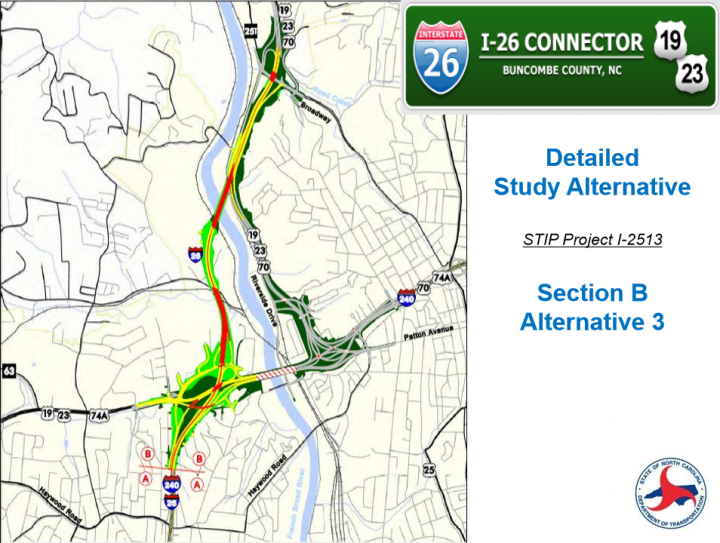
- Length/features:
- On I-26: 2.4 miles
- On I-240: 0.6 miles
- Total length: 3 miles
- Interchanges: 2
- Railroad crossings: 3
- Waterway crossings: 2
- Cost:
- Construction: $190,200,000
- Right-of-way: $42,800,000
- Utilities: $3,100,000
- Total cost: $236,100,000
- Relocations:
- Residential: 34
- Business: 24
- Nonprofit: 2
- Total: 60
- Schools: 0
- Churches: 0
- Parks impacted: 0
Alternative 3c:
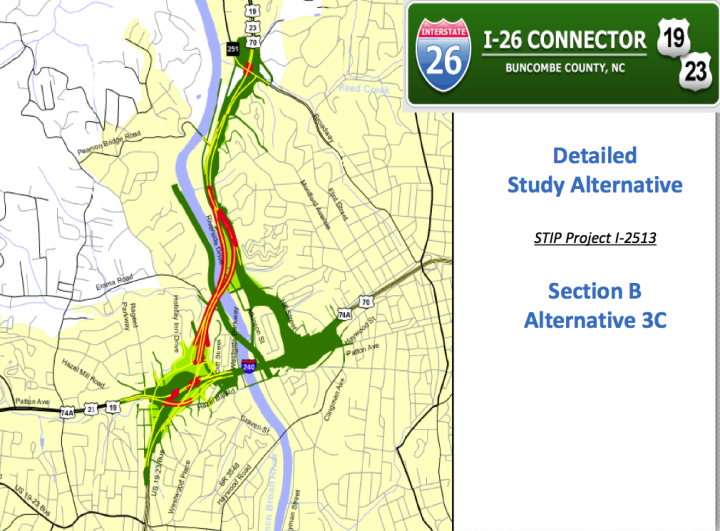
- Length/features:
- On I-26: 2.5 miles
- On I-240: 0.6 miles
- Total length: 3.1 miles
- Interchanges: 2
- Railroad crossings: 3
- Waterway crossings: 3
- Cost:
- Construction: $191.2 million
- Right-of-way: $36.2 million
- Utilities: $3.3 million
- Total cost: $230.7 million
- Relocations:
- Residential: 23
- Business: 33
- Nonprofit: 1
- Total: 57
- Schools: 0
- Churches: 0
- Parks impacted: 0
Alternative 4:

- Length/features:
- On I-26: 2.4 miles
- On I-240: 1.5 miles
- Total length: 3.9 miles
- Interchanges: 3
- Railroad crossings: 8
- Waterway crossings: 4
- Cost:
- Construction: $255.6 million
- Right-of-way: $45.5 million
- Utilities: $3.6 million
- Total cost: $304.7 million
- Relocations:
- Residential: 46
- Business: 24
- Nonprofit: 2
- Total: 72
- Schools: 0
- Churches: 1
- Parks impacted: 0
Alternative 4b:
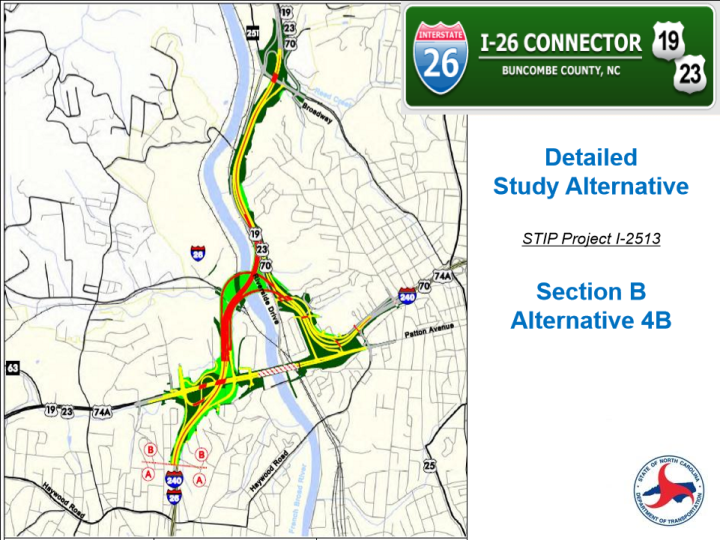 Length/features:
Length/features:
- On I-26: 2.5 miles
- On I-240: 1.5 miles
- Total length: 4 miles
- Interchanges: 3
- Railroad crossings: 5
- Waterway crossings: 4
- Cost:
- Construction: $291.3 million
- Right-of-way: $36.8 million
- Utilities: $3.9 million
- Total cost: $332 million
- Relocations:
- Residential: 33
- Business: 34
- Nonprofit: 1
- Total: 68
- Schools: 0
- Churches: 1
- Parks impacted: 0
Section A:
- Length/features:
- On I-26: 2 miles
- On I-240: 0 miles
- Total length: 2 miles
- Interchanges: 3
- Railroad crossings: 0
- Waterway crossings: 0
- Cost:
- Construction: $105.7 million
- Right-of-way: $29.4 million
- Utilities: $3.4 million
- Total cost: $138.5 million
- Relocations:
- Residential: 81
- Business: 17
- Nonprofit: 1
- Total: 99
- Schools: 1
- Churches: 1
- Parks impacted: 2
Section C:
The biggest difference in the Section C alternatives stems from the style of its interchange ramps.
Alternative A2:
- Ramps:
- Flyover (bridges): 4
- Loop: 0
- Length/features:
- On I-26: 2.2 miles
- On I-40: 2.9 miles
- Total length: 5.1 miles
- Interchanges: 3
- Railroad crossings: 2
- Waterway crossings: 1
- Cost:
- Construction: $286.1 million
- Right-of-way: $26.6 million
- Utilities: $2.2 million
- Total cost: $314.9 million
- Relocations:
- Residential: 50
- Business: 6
- Nonprofit: 0
- Total: 56
- Schools: 0
- Churches: 1
- Parks impacted: 1
- Ramps:
- Flyover (bridges): 2
- Loop: 2
- Length/features:
- On I-26: 2.2 miles
- On I-40: 3.2 miles
- Total length: 5.4 miles
- Interchanges: 3
- Railroad crossings: 2
- Waterway crossings: 1
- Cost:
- Construction: $269.7 million
- Right-of-way: $22.4 million
- Utilities: $2 million
- Total cost: $294.1 million
- Relocations:
- Residential: 32
- Business: 6
- Nonprofit: 0
- Total: 38
- Schools: 0
- Churches: 1
- Parks impacted: 1
Alternative D1:

- Ramps:
- Flyover (bridges): 3
- Loop: 1
- Length/features:
- On I-26: 2.2 miles
- On I-40: 2.8 miles
- Total length: 5 miles
- Interchanges: 3
- Railroad crossings: 2
- Waterway crossings: 1
- Cost:
- Construction: $263.1 million
- Right-of-way: $33.8 million
- Utilities: $2.3 million
- Total cost: $299.2 million
- Relocations:
- Residential: 38
- Business: 7
- Nonprofit: 0
- Total: 45
- Schools: 0
- Churches: 1
- Parks impacted: 1
Alternative F1: 
- Ramps:
- Flyover (bridges): 3
- Loop: 1
- Length/features:
- On I-26: 2.2 miles
- On I-40: 2.8 miles
- Total length: 5 miles
- Interchanges: 3
- Railroad crossings: 2
- Waterway crossings: 1
- Cost:
- Construction: $203.3 million
- Right-of-way: $17.1 million
- Utilities: $2.1 million
- Total cost: $222.5 million
- Relocations:
- Residential: 31
- Business: 5
- Nonprofit: 0
- Total: 36
- Schools: 0
- Churches: 1
- Parks impacted: 1



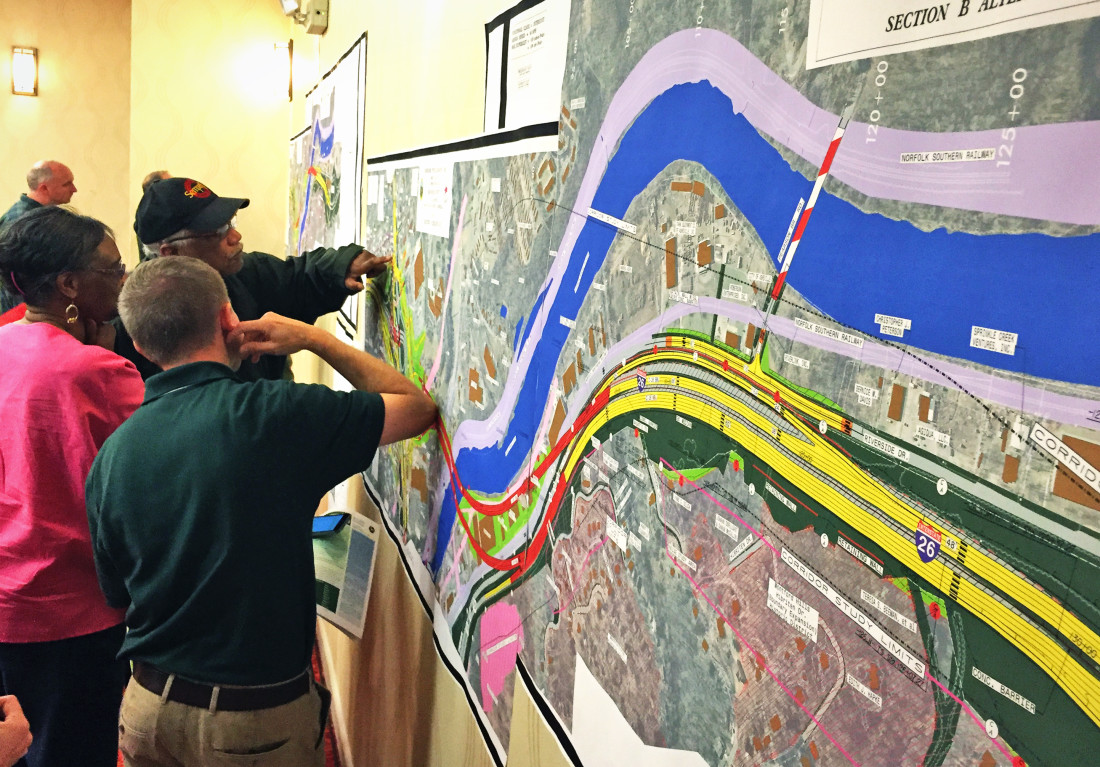
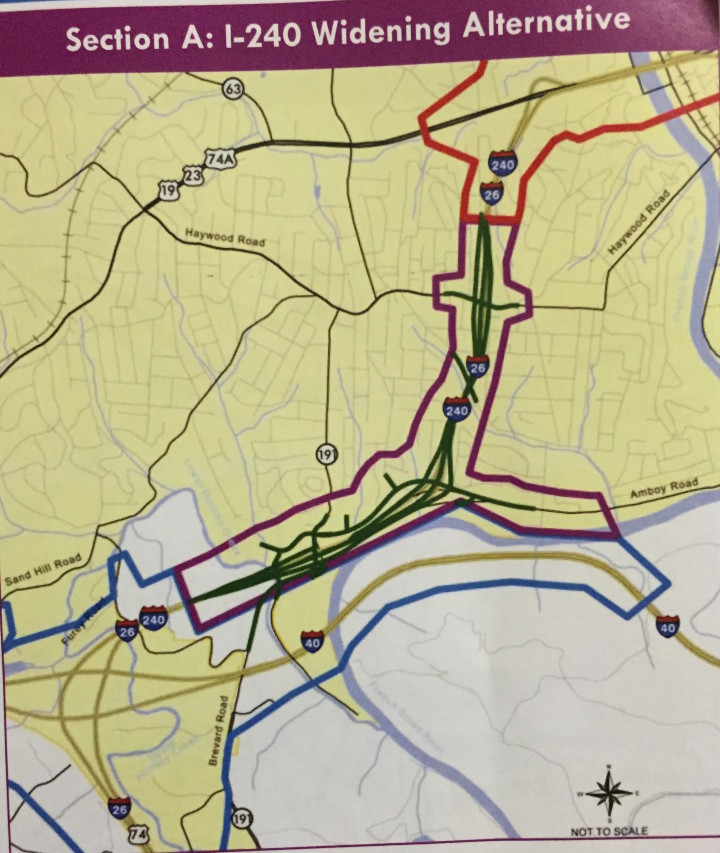
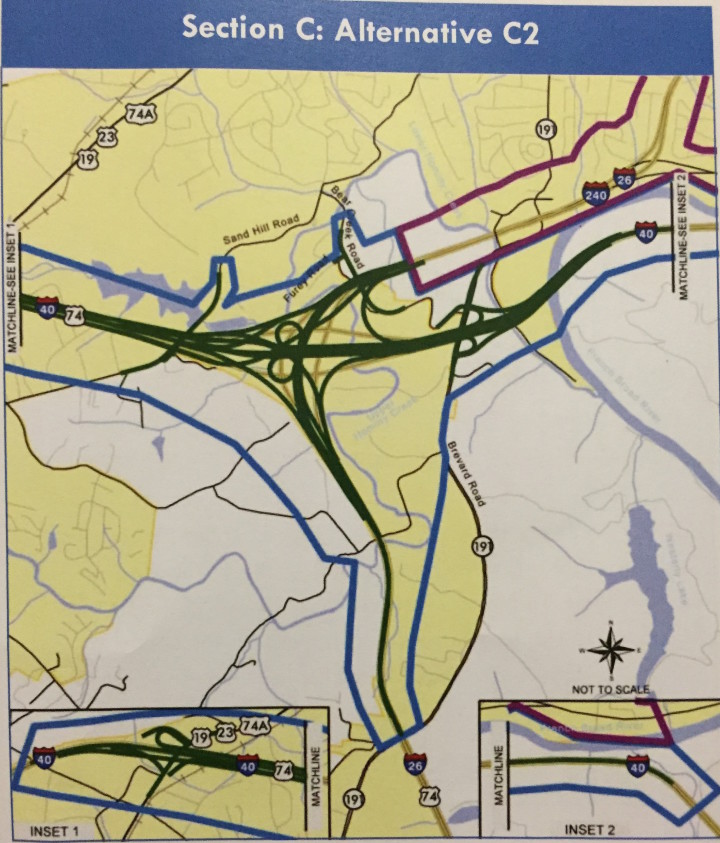
The descriptions for Section C should refer to the miles of widening on I-40, not I-240. DOT proposes widening I -40 from west of Smoky Park Highway to east of Brevard Road. Some sections would be widened to 12 lanes.
Oops! Thanks for pointing that out. That was a typo.
The citizens of North Mecklenburg and south Iredell counties are begging for one general purpose lane on I77 because of the gridlock but we are told there is no money and instead we get toll lanes built by a corrupt Spanish company who is famous for going bankrupt. Yet I see all this money available for this project. Quite frankly, I do not trust NCDOT. They have been caught in so many lies.